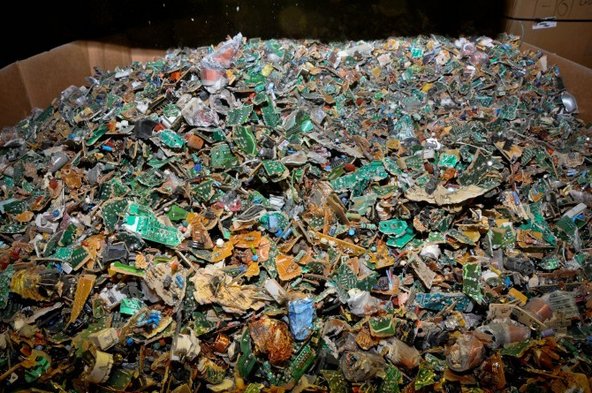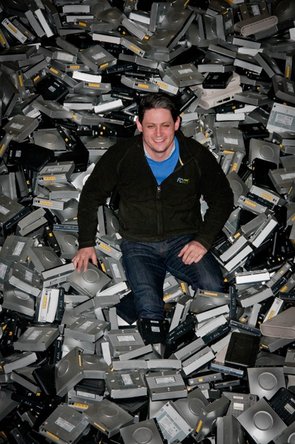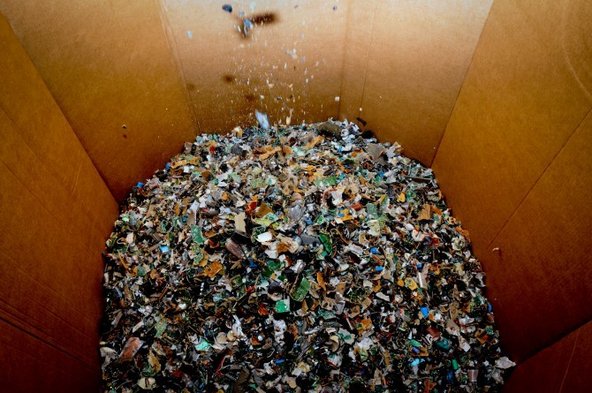Servers were the size of refrigerators and a single CPU chip had about $300 of gold when Montreal-based electronics recycling company FCM Recycling started harvesting precious metals from computers’ circuit boards and memory. Last week, I chatted with FCM representatives Chris and Andrew about the the work they’re doing and the e-waste climate in Canada.
FCM was founded as a small metals recycling facility in 1991, when electronic waste was a new enough problem that it hadn’t been legislated or regulated. They would dissolve circuit board fiberglass in big vats of caustic acid, to collect the gold, silver, and palladium left behind. Any materials they couldn’t use were discarded.
Eventually, as computers got smaller (and used less precious metal), FCM became a more traditional scrapyard. Then, in 2005, they were approached by Recyc-Québec, a government body that takes care of recycling mandates, about starting provincial electronics recycling programs. They installed their first shredder in 2007 and started processing e-waste in Québec.
Growing from Coast to Coast
Since then, they have expanded across the country: two facilities in Ontario (Cornwall and Toronto), two in Québec (and will be opening up a third in Québec City), one in the Maritimes (Halifax), and one in British Columbia. Their main shredder is in Montreal—other locations collect, sort, and dismantle electronics, and then send the materials to Montreal.
Today, thanks to regulation, urban mining, corporate participation, and better recycling practices, far less material ends up in landfills than 20 years ago. FCM now treats about 30 millions pounds of electronic goods per year, everything from cell phones and laptops to medical equipment. They trash less than 1% of all the material that goes through their facility, including all packaging material (shrink-wrap, gaylords, bags, skids—everything). The rest is recycled into various products: wire, ferrous and non-ferrous scrap, and a clean plastic shred. They have special processing lines for getting indium from flat screens and mercury from mercury switches.
How is E-Waste Different in Canada?
So what’s different about e-waste recycling in Canada? Not much, at one level. The tools and the process are pretty much identical to those used by US recyclers. Shredders like the one in the picture above can be found at almost any large e-waste recycling facility around the globe.
National regulations are fairly similar, too. Just like the US R2 and e-Stewards certifications, Canadian recyclers are certified by Electronics Product Stewardship Canada (EPSC), which lays out health and safety workplace guidelines, requirements for environmentally friendly e-waste processing, and regulations about what can be exported to other countries. EPSC, Chris and Andrew say, is maybe slightly more rigid about downstream accountability—they have to do a little bit more tracking of raw materials that leave their facility. Unlike the US, Canada has ratified the Basel Convention and prohibits export of unfinished goods to non-OECD countries (any country not on this list, that is).
E-waste management is funded somewhat differently in Canada. In the US, e-scrap is what Andrew calls “a commodity market”—in many states, people are paid for the materials they bring in. In Canada, he says, although individual recyclers are for-profit businesses, e-waste as a whole is “more of a social program supported by eco-fees.”
But the biggest difference between the US and Canada is in the way EPSC works to harmonize standards across provinces. Because the EPA encourages states to develop their own hazardous waste regulations, the requirements for US recyclers vary drastically from state to state. So far, 25 states have e-waste legislation, but the laws are conflicting and confusing. Sometimes recyclers pay, sometimes manufacturers pay, sometimes consumers pay. Because of the varying demands of different state laws, R2/RIOS, and e-Stewards, it’s difficult for a US recycler to expand into other states the way FCM has expanded into other provinces. Only a few US recyclers, such as Electronics Recyclers International, have locations in multiple states. Some attempts to harmonize US laws have been made—there’s an organization dedicated to harmonizing US e-waste laws called the Electronics Recycling Coordination Clearinghouse. No efforts, however, have been as effective as EPSC.
Harmonization does slow down the process of starting a new program a bit—Chris says that the biggest hurdle is that the entire collection, payment, and auditing system has to be set up before a program can launch. But it also enables companies like FCM to expand across the country, without having to meet vastly different standards from province to province.
Cell Phone Refurbishment
And the vast network of connections they’ve made by expanding—they are involved with national organizations like Big Brothers Big Sisters and the Scouts—helps them get the volume they need for new projects, such as the cell phone reuse and refurbishment program they are starting this year. Andrew says they receive more than 8,000 cell phones each month. Not all of those are reusable, of course. He points out that often it may not be worth the time, effort, and transportation costs involved in refurbishing a device, if it will end up in a landfill in six months anyway.
But many of the phones they receive could easily have a couple more years of useful life. Smartphone sales just overtook desktop sales for the first time last year, Andrew tells me, quoting a recent E-Scrap News article. Many of those sales are people upgrading from one smartphone to another. Our friends at Recellular, for example, say they always receive a big influx of phones on the day a new smartphone is announced. So FCM is taking steps to begin selling refurbished phones.
How Do You Find a Recycler in Canada?
We haven’t visited FCM and so can’t give them our personal seal of approval, but they’re certified by a number of external ratings boards—as any recycler you use should be. If you’re in Canada and not near an FCM location, what do you do with your used electronics? Although Canadian provinces are working to harmonize their programs at a legislative level, unfortunately there doesn’t appear to be a searchable database of recyclers equivalent to Earth911 for the US. You do have a few good options: use a take-back program at a retail store such as Best Buy, search for recycling programs within your province (there’s a pretty good list here), or find a charity that accepts donated electronics such as The Electronics Recycling Association.
Recyclers can’t mine $300 of gold from a single CPU chip anymore, but there are many more recyclers today than 20 years ago. And thanks to FCM and other recyclers like them, fewer devices are ending up in landfills.







crwdns2944067:00crwdne2944067:0